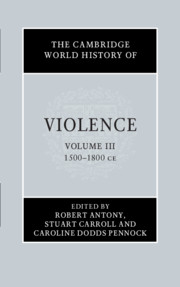Book contents
- The Cambridge World History of Violence
- The Cambridge World History of Violence
- The Cambridge World History of Violence
- Copyright page
- Contents
- Figures
- Maps
- Contributors to Volume iii
- Introduction to Volume iii
- Part I Empire, Race and Ethnicity
- 1 Terror, Horror and the British Atlantic Slave Trade in the Eighteenth Century
- 2 Violence, Slavery and Race in Early English and French America
- 3 Race and Violence in Portuguese America
- 4 Violence and Religion in the Ottoman Empire
- 5 Human Sacrifice, Ritualised Violence and the Colonial Encounter in the Americas
- Part II Cultures of War and Violence
- Part III Intimate and Gendered Violence
- Part IV The State, Punishment and Justice
- Part V Popular Protest and Resistance
- Part VI Religious and Sacred Violence
- Part VII Representations and Constructions of Violence
- Index
- References
3 - Race and Violence in Portuguese America
from Part I - Empire, Race and Ethnicity
Published online by Cambridge University Press: 13 March 2020
- The Cambridge World History of Violence
- The Cambridge World History of Violence
- The Cambridge World History of Violence
- Copyright page
- Contents
- Figures
- Maps
- Contributors to Volume iii
- Introduction to Volume iii
- Part I Empire, Race and Ethnicity
- 1 Terror, Horror and the British Atlantic Slave Trade in the Eighteenth Century
- 2 Violence, Slavery and Race in Early English and French America
- 3 Race and Violence in Portuguese America
- 4 Violence and Religion in the Ottoman Empire
- 5 Human Sacrifice, Ritualised Violence and the Colonial Encounter in the Americas
- Part II Cultures of War and Violence
- Part III Intimate and Gendered Violence
- Part IV The State, Punishment and Justice
- Part V Popular Protest and Resistance
- Part VI Religious and Sacred Violence
- Part VII Representations and Constructions of Violence
- Index
- References
Summary
This chapter examines the history of racial violence in Portuguese America as a transatlantic coercive pedagogy. It considers the ideas and methods refined by secular and ecclesiastical authorities to teach peoples of indigenous and African descent, as well as white settlers, about the parameters governing the permissible use of force. Concentrating on the enslavement of Indians and blacks, it examines how colonisers came to accept violence organised along racial lines. The Portuguese devised an array of practices intended to inflict physical and psychological harm on early Brazil’s non-white majority population. Imperial authorities rationalised physical aggression as necessary, virtuous and just, deeming violence indispensable as an instructional practice intended to communicate and secure the dominant position of Portuguese settlers. They did so by making biologised judgements about native, African and mixed-race peoples. They then translated these judgements into punitive acts orchestrated to achieve didactic effects. The chapter concentrates on sixteenth- and seventeenth-century efforts to assemble and control the largest enslaved workforce in the Americas.
- Type
- Chapter
- Information
- The Cambridge World History of Violence , pp. 55 - 76Publisher: Cambridge University PressPrint publication year: 2020

